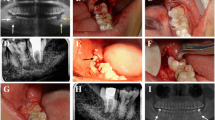Abstract.
Material and Methods: The aim of this study was to assess the effects of atrophy of the alveolar process and subsequent orthodontic treatment on the transplantation results of developing third molars. The material consisted of 35 teeth transplanted to an atrophied alveolar process. 19 of these teeth were treated orthodontically subsequent to transplantation. The control group consisted of 61 developing molars transplanted to a new extraction socket. The transplanted teeth were followed up clinically and radiographically for a mean period of 3.2 years.
Results: The success rate was 85% for transplants to new extraction sockets and 84% for transplants to atrophied jaw sections with subsequent orthodontic treatment. In contrast, transplants to atrophied jaw sections without subsequent orthodontic treatment showed a significantly (p ≤ 0.001) lower success rate of only 37.5%. These poorer results were due to persistent infraocclusion and ankylosis.
Conclusions: Even in cases with atrophy of the alveolar process, a transplantation with subsequent orthodontic treatment represents a promising treatment concept, whereas teeth without subsequent orthodontic treatment showed a lower success rate. Orthodontic tooth movement had no negative effect on the healing rates of transplanted developing third molars.
Zusammenfassung.
Material und Methoden: Ziel dieser Studie war es, den Einfluss einer Alveolarfortsatzatrophie und einer anschließenden kieferorthopädischen Einordnung auf die Transplantationsergebnisse von Keimen dritter Molaren zu überprüfen. Das Untersuchungsmaterial bestand aus 35 in einen bereits atrophierten Alveolarfortsatz transplantierten Zähnen. 19 dieser Zähne wurden anschließend noch kieferorthopädisch eingeordnet. Als Kontrolle dienten 61 in eine frische Extraktionsalveole transplantierte Keime. Die Zähne wurden durchschnittlich 3,2 Jahre klinisch und radiologisch nachuntersucht.
Ergebnisse: Die Erfolgsrate für Transplantationen in frische Extraktionsalveolen lag bei 85%, für Transplantationen in atrophierte Kieferabschnitte mit kieferorthopädischer Einordnung bei 84%. Dagegen zeigten die Transplantationen in atrophierte Kieferabschnitte ohne anschließende kieferorthopädische Einordnung mit nur 37,5% eine signifikant (p ≤ 0,001) schlechtere Erfolgsquote. Für die schlechteren Ergebnisse waren verbleibende Infraokklusionen und Ankylosen verantwortlich.
Schlussfolgerungen: Auch bei Alveolarfortsatzatrophie stellt die Transplantation in Kombination mit der kieferorthopädischen Einordnung ein erfolgversprechendes Therapiekonzept dar, wohingegen nicht kieferorthopädisch nachbehandelte Zähne eine niedrigere Erfolgsrate zeigen. Die kieferorthopädische Bewegung hatte keinen negativen Einfluss auf die Einheilungsergebnisse transplantierter dritter Molarenkeime.
Similar content being viewed by others
Author information
Authors and Affiliations
Additional information
Received: December 21, 2001; accepted: July 15, 2002
Rights and permissions
About this article
Cite this article
Bauss, O., Sadat-Khonsari, R., Engelke, W. et al. Results of Transplanting Developing Third Molars as Part of Orthodontics Space Management . Journal of Orofacial Orthopedics / Fortschritte der Kieferorthopädie 64, 40–47 (2003). https://doi.org/10.1007/s00056-003-0132-y
Issue Date:
DOI: https://doi.org/10.1007/s00056-003-0132-y




